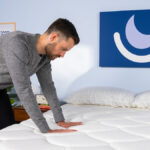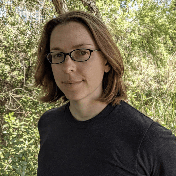Cheyne-Stokes breathing is an abnormal breathing pattern found in around 50% of people with central sleep apnea (CSA). Also referred to as Cheyne-Stokes respiration, this pattern gets its name from the two physicians, Dr. John Cheyne and Dr. William Stokes, who first identified it in the 19th century.
What Is Cheyne-Stokes Breathing?
Cheyne-Stokes breathing is an abnormal pattern in which a person’s breathing fluctuates between shallow and heavy breaths. Although this breathing pattern can happen at any time of the day or night, it most commonly develops during sleep.
Doctors also describe Cheyne-Stokes breathing as having a cyclic crescendo-decrescendo pattern. This is because a person’s breathing will slow down as the body stops making an effort to breathe and then speed up and increase in depth. Once the rate and depth of breathing reach a crescendo, they begin to fall again as the cycle repeats.
When Cheyne-Stokes breathing happens during sleep and involves brief pauses in breathing during each decrescendo, it may be diagnosed as a type of central sleep apnea. CSA is a condition in which breathing is disrupted during sleep due to communication issues between the brain and the muscles responsible for breathing.
What Are Symptoms of Cheyne-Stokes Breathing?
The main symptom of Cheyne-Stokes breathing is the cyclical pattern of shallow and heavy breathing. A person experiencing Cheyne-Stokes respirations may have a range of other symptoms, depending on the pattern’s underlying cause.
Central sleep apnea with Cheyne-Stokes breathing can lead to a number of sleep-related symptoms, including:
- Trouble falling or staying asleep
- Snoring
- Shortness of breath when waking up
- Headaches in the morning
- Feeling sleepy during the day
- Difficulty staying focused
Causes of Cheyne-Stokes Breathing
Researchers are still working to understand why Cheyne-Stokes breathing happens. A common theory is that Cheyne-Stokes occurs when there is a delay in how long it takes for the brain to detect and respond to changes in the level of carbon dioxide in the blood. Several medical conditions are linked to central sleep apnea with Cheyne-Stokes breathing.
- Heart failure: This is a health condition where the heart struggles to deliver blood to the rest of the body. Up to 50% of those with heart failure experience Cheyne-Stokes breathing.
- Stroke: A stroke occurs when blood flow is cut off to part of the brain. Around half of people will develop CSA with Cheyne-Stokes breathing after a stroke.
Cheyne-Stokes breathing is also linked to changes in altitude as well as other medical conditions like kidney failure and those that affect the nervous system.
Cheyne-Stokes Breathing vs. Other Breathing Conditions
In addition to Cheyne-Stokes breathing, there is a wide range of other breathing conditions involving abnormal breathing.
- Central Sleep Apnea Without Cheyne-Stokes Breathing: Not everyone with CSA experiences Cheyne-Stokes breathing. Central sleep apnea without Cheyne-Stokes breathing involves repeated pauses in respiration during sleep without a crescendo-decrescendo pattern in breaths.
- Obstructive Sleep Apnea: Obstructive sleep apnea (OSA) is the most common type of sleep apnea and is not associated with Cheyne-Stokes breathing. Breathing interruptions in people with OSA are caused when tissues collapse in the airway during sleep, briefly restricting or blocking breathing.
- Biot’s Respirations: In Biot’s respiration, a person’s breathing randomly fluctuates between deep, rapid breaths and short pauses in breathing. This type of breathing may occur during opiate use and when the part of the brain that controls breathing is damaged due to a stroke or other condition.
- Kussmaul Breathing: This abnormal breathing pattern involves deep breaths taken at a consistent rate. Kussmaul breathing is caused by a buildup of acid in the body, which can occur in people with uncontrolled diabetes, kidney disease, and toxic ingestion of certain medications and other substances.
How Cheyne-Stokes Respirations Are Diagnosed
If doctors suspect that a person has central sleep apnea, Cheyne-Stokes breathing may be detected during a sleep study. A sleep study is an overnight medical exam that monitors various processes in a person’s body as they sleep. Though widely available, a home sleep test is not a reliable way to diagnose Cheyne-Stokes breathing.
A sleep study usually takes place at a specialized sleep center and is monitored by a trained specialist. The sleep center offers a comfortable place to sleep while allowing a health care provider to record key data while a person sleeps, including:
- Heart rate
- Breathing rate and effort
- Airflow
- Oxygen levels in the blood
- Eye and body movements
- Brain and muscle activity
This data allows the sleep specialist or other medical professional to identify sleep disorders, including sleep-related breathing issues like CSA with Cheyne-Stokes breathing.
Treatment Options for Cheyne-Stokes Breathing
Doctors treat central sleep apnea with Cheyne-Stokes breathing by addressing the underlying cause and taking steps to normalize nighttime breathing. For example, treatment of heart failure may lead to a decrease in the frequency of Cheyne-Stokes breathing.
While doctors often begin by treating the cause of breathing issues, this may not completely resolve Cheyne-Stokes breathing. For this reason, doctors may also recommend treatments focused on restoring a normal breathing pattern, such as:
- Continuous positive airway pressure (CPAP) therapy
- Supplemental oxygen during sleep
- Medications
- Surgery to implant a device that regulates breathing
References
Ask the Sleep Doctor
Have questions about sleep? Submit them here! We use your questions to help us decide topics for articles, videos, and newsletters. We try to answer as many questions as possible. You can also send us an email. Please note, we cannot provide specific medical advice, and always recommend you contact your doctor for any medical matters.


